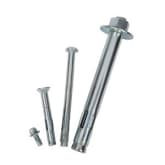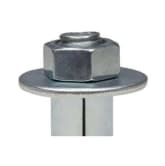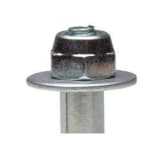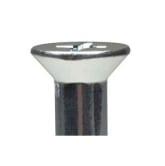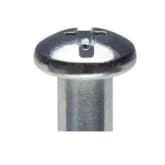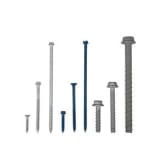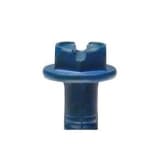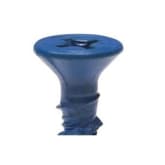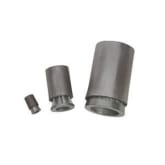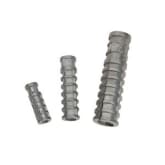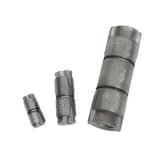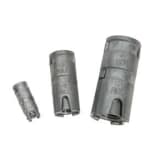Brick Anchors
Published by Robert Carlisle on Jan 23rd 2020
Brick anchor fasteners attach an item to bricks or mortar joints in a brick wall. Brick anchors are used in place of concrete fasteners because brick contains hollow spaces, unlike concrete that is solid. The hollow space requires a brick anchor in order to obtain the needed holding values in the hollow areas. Most brick anchors can also be used in concrete walls as well. Inserting brick anchors requires the use of a hammer drill and a masonry bit.
Male Expansion Brick Anchors (Sleeve Anchors)
The sleeve anchor is the most common male expansion type anchor for brick walls. It provides the most consistent holding values. By design the sleeve anchor expands over a greater surface area than other types of expansion anchor. This gives the sleeve anchors the ability to expand properly in the hollow or solid sections of brick. A sleeve anchor also works well in solid mortar joints. The mortar quality and quantity are most important to determine the sleeve anchor's ultimate holding value. There are many applications for sleeve anchors; one drawback is the lower shear strength than a similar female anchor. The sleeve anchor’s designated size is equal to the outside diameter, and the stud is smaller. For example, a 3/8" sleeve anchor has a 5/16" stud. This gives the sleeve anchor a shear strength of a 5/16" anchor and not of a true 3/8" diameter fastener.
Available diameters – The sleeve anchor comes in six diameters and in several lengths for use in a variety of applications. To get the minimum sleeve anchor length, add the item's material thickness to the minimum embedment of the sleeve anchor.
Available head styles – Sleeve anchors are available with several head styles: acorn head, hex head, round head and flat head. The acorn head is hex with a finished acorn head; the hex head is the standard hex nut; the round head is slotted for use with a straight screwdriver; the flat head is a countersunk Phillips or slotted drive. Select the head style based on the application where the sleeve anchor will be used.
Sleeve Anchor Lengths – The length of the sleeve anchor is measured from under the head for the acorn, hex head and round sleeve anchors. The flat-head sleeve anchor is measured as an overall length.
Materials – Sleeve Anchors come in carbon steel and 304 stainless steel. Selecting the correct material depends on the environment where the anchors are installed.
Self-Tapping Brick Masonry Anchors (Tapcon®/Concrete Screws)
Self-tapping brick anchors, concrete block or concrete screws are used for fastening items to brick. Concrete screws are most commonly called Tapcon® masonry screws. The heavy-duty masonry screw has the versatility for use in brick, mortar joints, CMU, block or solid concrete. Install the masonry screw in brick by selecting a carbide bit with the correct diameter for that screw. Drill a pilot hole with a hammer drill with the carbide bit. Insert the masonry screw anchor into the hole in the brick and turned clockwise. This will tap threads into the brick and hold the screw securely.
Masonry Brick Screw Sizes – The standard masonry brick screw comes in two diameters of 3/16", 1/4", 3/8" and 1/2" with lengths ranging from 1-1/4" to 6-1/4". The minimum length of masonry brick screw is determined by adding the minimum embedment depth of 1 ” to the thickness of the material being fastened.
Head Styles – Two head styles are available with the standard masonry brick screw: the hex washer slotted, and the flat countersunk Phillips. All the hex washer slotted masonry brick screws lengths are measured from under the head and the flat countersunk Phillips is measured as an overall length.
Materials – Depending on the environment, concrete screws come in carbon steel, galvanized, 304 stainless steel, 316 stainless steel, or 410 stainless steel.
Female Brick Expansion Anchors
Several different types of female brick anchors are available. The best one to use depends on preference and the specific application. Each female anchor requires a bolt and washers to be purchased separately. Many times, the bolt chosen will determine the female anchor that will be used. If a lag screw is used, then you would use the lag shield brick anchor. If a bolt is used with national coarse threads, then any of the female brick anchors with internal national coarse threads can be used. Some female brick anchors require a setting tool to be used to set the brick anchor into the base material. These types of brick anchors require that the anchor is placed so that setting tool can set the anchor into the brick properly.
Types of Female Brick Anchors
Machine Screw Anchors – Often called AJ’s or lead anchors, they require a setting tool that has national coarse threads. They are available in eight diameters and can be used in brick, block or concrete.
Lag Shield Anchors – These anchors are available in two different lengths of a short or long version and six diameters. The lag shield is very versatile because it can be used in very dense base material or in the base material where the holding values are suspect. The lag shield does not require a setting tool and is expanded by inserting the correct lag screw into the anchor.
Double Expansion and Single Expansion Anchors – These anchors both come in five diameters, have national coarse internal threads and have good holding values in most base materials. The double expansion expands the entire length of the anchor body as opposed to the single expansion that expands at one end. The double expansion anchor is best for cases where the base material may be soft, suspect or inconsistent.
Brick anchors are fasteners that attach an item to brick or a mortar joint in a brick wall.
Common Brick Anchor Uses
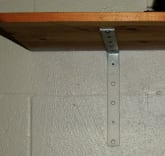
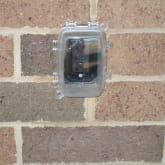
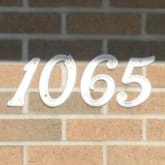
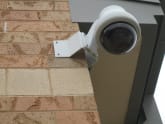
Among the many uses for brick anchors the most common are for installing shelving brackets, security cameras, electrical boxes, house street numbers and EXIT signs. The variety of anchors available will make these installations fairly easy. Sleeve anchors may be the best choice, as they have many head styles available for ease of installation and the look of the final installation.
Required Safety Equipment
When drilling a hole to install a brick anchor, make sure to have tools on hand to remove residual dust from the hole. This could be compressed air, a wire brush or a shop vacuum.
Now that you have the appropriate hammer drive drill and masonry drill bit, you should think about safety equipment. Safety goggles are a must to protect eyes from dust and concrete chips. Because of the dust, you may also want to consider wearing a dust mask. All drilling jobs tend to be noisy, but hammer drilling is considerably louder than standard drilling. Therefore, ear protection is important (especially for larger jobs).

